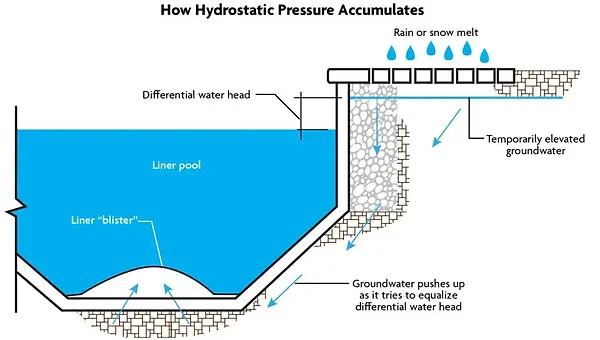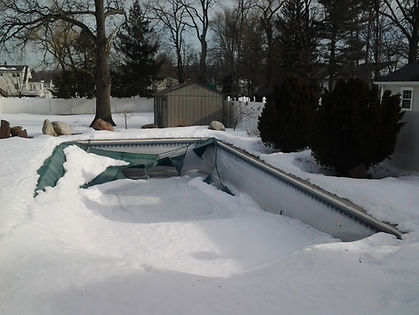Pool Water Level & Draining FAQs

One of the biggest sources of confusion for pool owners is what the proper water level is for their pool. The fact is, that the "proper" level is different based on the time of year and circumstances. Read through this page to get a better understanding of where your pool's water level should be maintained at various points throughout the season.
Jump to section
Beginning of Season Water Level
(From opening through the first few weeks.)
-
When the pool is first opened the water level is typically higher than normal due to rain that has filtered through the cover and accumulated in the pool during the spring. This is a GOOD thing!
-
Having excess water in the pool right after opening allows for all of the waste vacuuming and backwashing that needs to take place to get the pool clean and clear WITHOUT having to add additional water. As much as possible, we want to avoid adding water right after the pool is opened because it will add phosphates which can slow the clearing process.
-
Even though the higher water level means the skimmers might not be as effective at pulling debris off the surface of the pool, the net result is much better with the water level being high.
-
The bottom line is that excess water should NOT be drained from the pool until it is totally clean and clear!
In-Season Water Level
-
Throughout the season the water level should be maintained at "mid-skimmer" level or higher. This means it should fall about halfway up the skimmer opening (or often with a pool that has a tile line it is easier to judge the level based on being halfway up the tiles). If you have a skimmer with a faceplate that has screws on it you'll want to have the water between the two middle screws or slightly higher.
-
When the water is at mid-skimmer or slightly higher then there is enough water for BOTH the pump and filtration system to operate properly AND the skimmers to operate effectively.
-
If the water is LOWER than mid-skimmer there is a good chance the pump will run dry and the filtration system (and heater if you have one) will not operate.
-
If the water is TOO high then there really are no issues EXCEPT that the skimmers won't operate as effectively and the pool may get more messy than it normally would.
-
The only exception to the mid-skimmer rule is that when the pool is very dirty or if there is a phosphate issue that requires treatment / wast vacuuming it is a good idea to overfill the pool AHEAD of the cleaning. That way the water level will still be high enough for the system to operate properly after the cleaning.
-
In general it is much better to have the water too HIGH than too LOW! It is very important that all pool owners monitor and maintain the proper water level throughout the season to make sure the filtration system (and heat) operate properly.
Water Level when the pool is Winterized
The most common misperception about pool water level is that it should be drained at the time of the pool closing. This is FALSE. It is important that the pool be at or near normal operating level when the pool is winterized. This is done to both ensure proper winterization and protect the pool from damage.

Ensuring proper Winterization
It may seem counter-intuitive but we do not want to the pool drained when it is winterized. While it would be more convenient for our crews to winterize a pool that had been lowered it makes it impossible to ensure the winterization was done properly. The myth of needing to drain out a pool for winterizing started because of people trying to DIY their pool closings. A homeowner that attempts to winterize their own pool with a shop vac or a compressor, can't adequately clear out the lines when the pool is full. We use commercial blowers that are specifically designed to winterize underground pipes even with the pool is full. Because the pool is full our guys end up getting a little wet during the closing as the water bubbles up, however it allows us to make SURE that all the plugs have sealed properly!
As shown in the images below if the water is at normal operating level we can see if a plug isn't sealed properly due air escaping by it. If the water is below the inlets or outlets there is no way to tell if the plug is 100% sealed. If it ISN'T sealed at the closing, then when the pool fills with rain water over the winter the winterization would become undone.

With the pool at normal level we can see that the plug hasn't fully sealed due to the air bubbles escaping into the water. This allows us to change the o-ring or plug and ensure it is 100% sealed.

With the water lowered there is no way to tell if a small amount of air is escaping past the plug. This leaves the pool prone to damage over the winter when the pool fills due to rain.
Protecting the pool from damage

All pools are subject to something called "Hydrostatic Pressure".
Put simply, the groundwater that is around the pool at all times is pushing inward on the pool walls, floor, and structure. The water inside of the pool that "pushes back" against that groundwater and keeps the pool stable and contributes to its structural integrity.
As long as the water level inside the pool is HIGHER than the groundwater around it then there are no issues. In-season when the water is at a normal level it is impossible for the groundwater to get higher than the level of water the pool. However, if a pool is drained for any reason (like when the pool is winterized) and then the groundwater around the pool were to rise (like when we get a lot of rain in the fall) then the pool can become damaged or destroyed due to the hydrostatic pressure.
This damage can affect vinyl liner, fiberglass, and gunite pools. For vinyl liners, hydrostatic pressure can cause the liner to "float" which at a minimum will cause washout of the floor underneath the liner and leave wrinkles behind when the water recedes. At worst, this can destroy the liner and result in a complete replacement being necessary. For fiberglass or gunite pools, hydrostatic pressure can cause cracking in the interior of the pool or, in extreme cases, something called "popping". When a pool "pops" that means that it rises up out of the ground like a boat and destroys itself and everything around it! We have seen this occur in RI when a homeowner drained water out of their pool.

Floating Liner

"Popped" Pool
Notice how both of these damaged pools have water that was lowered.
For this reason it is important to try to maintain the water level in the pool as high as possible, even during the winter.
Water Level while the pool is Closed
Given all of these factors, maintaining the proper water level over the winter is a delicate balance. If the water is too low then the pool can be damaged by hydrostatic pressure. If the water is too high then it can damage the tile line or coping and can cause water-related issues around the pool and deck area.
Objectives for pool water level over the winter:
-
Pool should be kept as full as possible without having it be TOO high.
-
Water level can't be allowed to get TOO low as that can put the pool at risk for damage.
-
Water level MUST be within 18" of deck level to protect the cover. Safety covers are designed to stretch a MAXIMUM of 18" due to snow weight on top of them. If the water is lower than 18" below deck the cover can be destroyed and the warranty is invalidated

Destroyed safety cover from snow weight / low water level
Because of these factors it is not advisable to drain a lot of water out all at once at the beginning of the winter like many people do. The best approach is to drain the pool out to the proper level (about 6" below the tile line / skimmer, but no more than 18" total below the deck) in late Fall, after the majority of rain has fallen and before freezing temperatures / snow occur. Thereafter, periodic inspections of the water level and additional draining of the pool should occur throughout the winter to maintain a consistent water level until the threat of freezing has passed.
Atlantis has designed our Winterguard program specifically to address these issues. While there is no foolproof way to protect your pool for every potential issue over the winter months, a measured and consistent approach to maintaining the proper water level during the off-season is your best bet!

